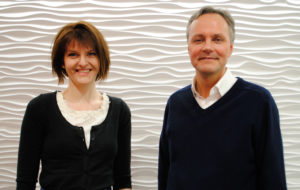
Researchers in Oxford have discovered an unexpected way in which different aspects of the skin’s defence system interact, and how they can go astray in skin inflammation.
This research, supported by the NIHR Oxford BRC, suggests a new line of investigation to develop treatments for conditions such as eczema.
The skin’s immune system is our first line of defence against invading pathogens. In certain conditions this protective system can act in an uncontrolled way, leading to skin inflammatory conditions.
Clare Hardman and Prof Graham Ogg of the MRC Human Immunology Unit, at the University of Oxford’s Radcliffe Department of Medicine, are studying an inflammatory skin disease called atopic eczema (or atopic dermatitis).
Prof Ogg said: “Atopic eczema affects 20-30% of children and 5-10% of adults in the UK. It is related to other allergic diseases such as asthma, hay fever and food allergies, which collectively carry an enormous burden on patients and their families.”
“If we can understand the pathways of disease in atopic eczema then we may be able to identify new routes to treatment,” said Prof Ogg, a principal investigator in the Oxford BRC’s Gastroenterology and Mucosal Immunity theme.
Sentinels
An important question in understanding how the skin immune system works, and how it goes astray, concerns whether the several players at work are able to interact. One such player is a population of Group 2 Innate Lymphoid Cells, also known as ILC2s. These act as sentinels, triggering other immune pathways when invading pathogens are detected.
In their publication in Science Immunology, Prof Ogg and his team looked for clues on how ILC2s act, and how they interact with other pathways in inflammation.
In order to do so, they examined healthy volunteers and patients with eczema, using a skin suction technique. Skin biopsies, where a piece of tissue is removed, are the conventional method used to study skin cells. This approach is not ideal, as examination of individual cells requires the tissue to be disrupted, which can interfere with the results.
“In our approach, a suction cup is applied over the skin, which forms a blister similar to those you can develop in the back of your foot.” explained Prof Ogg “The fluid within these blisters contains cells that are already separated, so no further processing is required.”
Using this technique, the researchers showed that ILC2s are able to interact with CD1a-reactive T cells, another immune response pathway suspected of playing a role in allergy and infection.
Future targets
The team showed that ILC2s signal information about the presence of allergens (such as house dust mites) or invading pathogens (such as Staphylococcus aureus) to the T-cells, but also trigger immune responses in unwanted contexts, such as in atopic eczema.
Importantly, these results suggest possible targets for future therapies. The team showed that the ILC2s can amplify subsequent immune responses by binding and presenting particular fat molecules, which can trigger an inflammation cascade.
“That cascade of inflammation can include the production of messenger molecules called cytokines. This offers the possibility of interfering with those cytokines for future treatment development,” Prof Ogg explained.
“Our next steps are to understand the nature of the fats that are triggering the immune cascade and the nature of the particular cytokines that the cells are producing, so that they might be modulated in future treatments.”
As well as the NIHR Oxford Biomedical Research Centre, this research was supported by the, NIHR Clinical Research Network and the Medical Research Council.